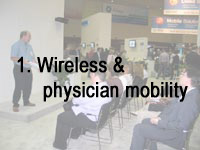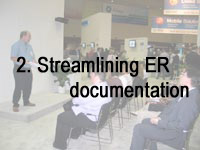 The Best-Practice Fairy is back with a fascinating article by Jeff Kelly on successful speech recognition implementation. No doubt that Mr. Kelly knows what he is talking about: before joining Inland Imaging, a 60-member private radiology group in Spokane, WA, as director of clinical applications, he used to perform RIS market analysis and consulting work for MedQuist on voice recognition implementation. As Kelly puts it in a 2007 AuntMinnie article, one question – “What’s in it for me?” – is the key to a speech recognition project’s success. His article sheds the most promising light on the implementation brain-teaser. Here are a few soothing extracts:
The Best-Practice Fairy is back with a fascinating article by Jeff Kelly on successful speech recognition implementation. No doubt that Mr. Kelly knows what he is talking about: before joining Inland Imaging, a 60-member private radiology group in Spokane, WA, as director of clinical applications, he used to perform RIS market analysis and consulting work for MedQuist on voice recognition implementation. As Kelly puts it in a 2007 AuntMinnie article, one question – “What’s in it for me?” – is the key to a speech recognition project’s success. His article sheds the most promising light on the implementation brain-teaser. Here are a few soothing extracts:
Strong support and leadership
Consider pulling in this diverse group of representatives into a VR task force that can meet at defined intervals to address issues and help break down barriers to success. Then use this task force to educate its members on voice recognition — keeping in mind that this is usually new technology for 90% of those involved. This task force can also function as the decision-making body behind the implementation.
Maximize benefit, minimize effort
A typical radiologist statement that must be addressed is, “I am not a transcriptionist.” You can respond to this statement on three levels. First, stress the improvement in patient care when the radiologists are able to review and edit the report at the same time as reviewing the films. No longer do they need to recall whether it was a left or a right shoulder MRI. The accuracy of the report immediately increases.
Second, by editing at the time of the report, they eliminate the time-consuming process of logging into the RIS/HIS at a later time and reviewing the report. Third, the ability to send to transcription still exists if they so desire.
Provide sufficient internal support
At Inland Imaging, an in-house trainer was designated to be with each radiologist for the first three days when they began using the technology. This level of support tapered to half of every day for the next three days, then reached a point in which only a phone call was necessary to check in on each radiologist. Keep in mind that each radiologist will be unique — some needing more support and some needing less.
Set realistic expectations
As stated before, the radiologists are going from a traditional bicycle they’ve ridden their entire life to a shiny new two-seater that they are going to share with a friend. This is no easy task. It’s important to be frank and honest with staff and radiologists about the implementation process. There will be application bugs. There will be times when the application or workstation stops responding. There will be days when they love the system, and days when they feel like throwing the whole thing out the window. Set these expectations up front, then address them as quickly as possible when they arise.
Making change last
Finally, maintain the health of the system. Continue to refresh hardware as necessary to optimize both client- and server-side performance. Maintain error logs and database optimization jobs. Continue to accept version upgrades. Don’t allow neglect of system maintenance responsibilities to have a damaging impact upon the workflow of its users.
> Read full article (registration required – free)
 Someone asked me to provide a few examples of healthcare facilities having deployed SpeechMagic in the front-end (process whereby the recognized text appears on screen as the physician dictates). It is my pleasure to oblige:
Someone asked me to provide a few examples of healthcare facilities having deployed SpeechMagic in the front-end (process whereby the recognized text appears on screen as the physician dictates). It is my pleasure to oblige: I would like to reply to the following
I would like to reply to the following 
 With an industrial history firmly rooted in technology, the Nordics have always been early hi-tech adopters, clearly ahead of new market trends. While, in the early 2000’s, the rest of Europe was still getting used to the very concept of online transactions, these guys were already buying books by the dozen from Amazon.com over broadband connections. The fact that Norvegian healthcare is about to roll-out the world’s largest speech recognition installation therefore comes as no surprise.
With an industrial history firmly rooted in technology, the Nordics have always been early hi-tech adopters, clearly ahead of new market trends. While, in the early 2000’s, the rest of Europe was still getting used to the very concept of online transactions, these guys were already buying books by the dozen from Amazon.com over broadband connections. The fact that Norvegian healthcare is about to roll-out the world’s largest speech recognition installation therefore comes as no surprise.
 I had promised an update on the MedQuist Saga outcome. Well, here it is; Season one’s grand finale. On March 10, MedQuist executed a $7,537,001.83 million settlement with “the plaintiffs and certain other putative class members represented by plaintiffs’ counsel in the South Broward customer class action.”
I had promised an update on the MedQuist Saga outcome. Well, here it is; Season one’s grand finale. On March 10, MedQuist executed a $7,537,001.83 million settlement with “the plaintiffs and certain other putative class members represented by plaintiffs’ counsel in the South Broward customer class action.” Marcel Wassink, Managing Director, Philips Speech Recognition Systems, speaks out in a recent interview conducted by HealthTechWire’s Armin Scheuer. Wassink shares his vision of market achievements and challenges, technology trends and the role to be played by speech recognition in the overall EMR agenda. Here is a sneak peek:
Marcel Wassink, Managing Director, Philips Speech Recognition Systems, speaks out in a recent interview conducted by HealthTechWire’s Armin Scheuer. Wassink shares his vision of market achievements and challenges, technology trends and the role to be played by speech recognition in the overall EMR agenda. Here is a sneak peek: Looks like speech recognition has left Star Trek to enter the mainstream. Hot like the southern breeze itself this year in Orlando, SR attracted crowds like never before. While physician skepticism seems to have vanished like a David Copperfield act, an increasing number of healthcare facilities came by the Crescendo and Philips booths to discuss technology advancements and upcoming implementation projects. These projects are bigger than ever, with a number of large healthcare groups looking to equip hundreds of physicians from multiple specialties with back-end SR, front-end SR, or both, by the end of the year. In this regard, attendee interest shifted from “does the technology work?” towards “how are other hospitals and clinics actually implementing it?”
Looks like speech recognition has left Star Trek to enter the mainstream. Hot like the southern breeze itself this year in Orlando, SR attracted crowds like never before. While physician skepticism seems to have vanished like a David Copperfield act, an increasing number of healthcare facilities came by the Crescendo and Philips booths to discuss technology advancements and upcoming implementation projects. These projects are bigger than ever, with a number of large healthcare groups looking to equip hundreds of physicians from multiple specialties with back-end SR, front-end SR, or both, by the end of the year. In this regard, attendee interest shifted from “does the technology work?” towards “how are other hospitals and clinics actually implementing it?”








More Comments on the SpeechMagic/Dragon Comparison
Published April 1, 2008 Market & vendors Leave a CommentTags: comparison, dragon, reader comments, speechmagic
Dear Eric, Dear David,
Eric is not the only one confused here. Actually, the bluriness that still prevails between consumer and professional speech recognition technology is what started this blog in the first place.
First, it is important to place my original thread in its context. I wrote this thread after I attended a congress on ER medicine where one doctor was explaining how he was using the off-the-shelf Dragon engine as an enterprise solution; an initiative that only reveals the overall market turmoil. To address users’ confusion, the best way is probably to analyze the reasons behind it. I believe the products’ respective sales models account for most of the blurriness:
This whole dichotomy in the sales approach is not without its historic explanations. As Eric rightly points out, both products come from different worlds, addressing different markets in the first place:
Regarding initial training: I am not sure which version of Dragon this doctor was using. I am only reporting his experience of using Dragon, which involved, in his own words, significant training time. Then again I am not questioning Dragon’s marketing speech here (who would I be to do so?), but only relaying a user specific testimonial.
Finally, David is rightly mentioning Enterprise Express (powered by Dragon) as an enterprise solution, which should be added to the list I provided on Friday.
May I conclude by inviting actual end users of any of the above systems to share their experience on this blog? I look forward to publishing your stories.